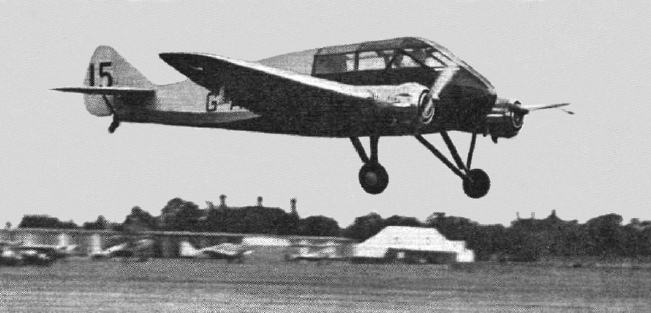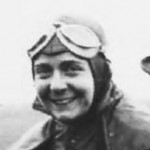
Monospar
In 1929, the Monospar Company Ltd was formed to offer new techniques of designing cantilever wings, based on the work of Swiss engineer Helmut J. Stieger, who headed the company.
About Monospar – Source Wikipedia
Role: Cabin monoplane
Manufacturer: General Aircraft Ltd
First flight: 1932
Number built: 45
Variants: Monospar ST-25, Monospar ST-12
Specifications (Monospar ST-12)
Data from The Illustrated Encyclopedia of Aircraft
General characteristics
- Capacity: 4
- Length: 26 ft 4 in (8.03 m)
- Wingspan: 40 ft 2 in (12.24 m)
- Height: 7 ft 10 in (2.30 m)
- Wing area: 217 ft2 (20.16 m2)
- Empty weight: 1,840 lb (835 kg)
- Gross weight: 2,875 lb (1,304 kg)
- Powerplant: 2 × de Havilland Gipsy Major 4-cylinder inverted inline piston engine, 130 hp (97 kW) each
Performance
- Maximum speed: 158 mph (254 km/h)
- Range: 410 miles (660 km)
- Service ceiling: 21,000 ft (6,400 m)

Monospar
In 1929, the Monospar Company Ltd was formed to offer new techniques of designing cantilever wings, based on the work of Swiss engineer Helmut J. Stieger, who headed the company.
Design and development
In 1929, the Monospar Company Ltd was formed to offer new techniques of designing cantilever wings, based on the work of Swiss engineer Helmut J. Stieger, who headed the company. The Monospar Company designed a twin-engined low-wing aircraft designated the Monospar ST-3, that was built and flown in 1931 by the Gloster Aircraft Company at Brockworth, Gloucestershire. After successful testing of the Monospar ST-3, a new company General Aircraft Ltd was formed to produce aircraft that used the new Monospar wing designs.
The first production design was the Monospar ST-4, a twin-engined low-wing monoplane with a fixed tailwheel landing gear and folding wings for ground storage. Powered by two Pobjoy R radial engines, the first aircraft (G-ABUZ) first flew in May 1932, and was followed by five production aircraft. The Monospar ST-4 Mk.II, an improved variant with minor differences, followed with a production run of 30. In 1933, the Monospar ST-6 appeared, a similar aircraft to the ST-4 with manually retractable landing gear and room for an extra passenger. The Monospar ST-6 was only the second British aircraft to fly with a retractable landing gear (the first, the Airspeed Courier, was flown a few weeks earlier). Another Monospar ST-6 was built, and two ST-4 Mk.IIs were converted. GAL then produced a developed version, the Monospar ST-10, externally the same but powered by two Pobjoy Niagara engines, an improved fuel system, and aerodynamic refinements.
The Croydon factory closed down in 1934, and a larger factory was opened in 1935 at London Air Park, Hanworth.
Operational history
The Monospar ST-10 prototype (G-ACTS) won the 1934 King’s Cup Air Race at an average speed of 134.16 mph. Only one other ST-10 was built, along with two similar ST-11s with de Havilland Gipsy Major engines for export to Australia. A production batch of ten Monospar ST-12 aircraft was based on the ST-11 with fixed landing gear.
Variants
Monospar ST-3
Experimental cantilever monoplane, one built.
Monospar ST-4
Cantilever touring monoplane, seven built.
Monospar ST-4 Mk.II
Improved variant of ST-4, 22 built, two later converted to ST-6 standard.
Monospar ST-6
As ST-4 with manual retractable landing gear, two built and two conversions from ST-4 Mk.IIs.
Monospar ST-10
Improved variant with two Pobjoy Niagara engines, two built.
Monospar ST-11
de Havilland Gipsy Major engined variant, two built.
Monospar ST-12
Fixed landing gear variant with two de Havilland Gipsy Major engines, 10 built.
Monospar ST-18
10 seat transport with two Pratt and Whitney Wasp Junior engines, one built.
Survivors
- One Monospar ST-12 (registration VH-UTH) is held by the Newark Air Museum, England

Monospar
In 1929, the Monospar Company Ltd was formed to offer new techniques of designing cantilever wings, based on the work of Swiss engineer Helmut J. Stieger, who headed the company.


